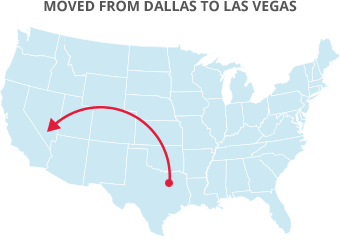
Out of all the months that people move in the United States, the winter months are by far the least used. There are perfectly valid reasons for this, and almost all of them are caused by the weather. After all, throughout most of the U.S., winter means snow, ice, sleet, cold temperatures, and less than ideal driving conditions. Here at A-1 Freeman, we’ve been through many winter seasons and we’ve seen just about every condition that can pop up. As such, we’ve decided to put together a guide on moving in the winter to present you with all the info you need to have a successful move.
- So to begin with, you need to keep a sharp eye on the weather as your move date comes close. If you’re going to have a lot of snow, if an ice storm is going to come through, or if the temperature is going to dip to below freezing, you need to know about it so you can prepare properly. If you’re going to get hit with a fresh layer of snow, you’re going to want clear off both your current home’s paths and your new home’s paths. Make sure that you have enough salt to adequately cover the sidewalks, driveways, and front sidewalks. You don’t want any slippery surfaces when people are hauling in heavy or bulky items.
- Be sure that you’re listening carefully to your local station that has frequent traffic updates. If the cold temperatures cause a water main to burst that’s on your route, you’ll definitely want to be able to preemptively reroute your caravan around the troubled area. If there’s a traffic jam or overly busy road, think about planning to go around it. If the roads are slick, there’s an increased chance for a collision that could damage your possessions and put a huge dent in your schedule.
- With as volatile as the weather can be, you’re going to want to plan your move for a week or two prior to your deadline of needing to evacuate your current residence if you can. This will allow you to have time to reschedule your move if you get a massive amount of snow or ice. Along with this, you’ll want to talk to your landlord or realtor about a possible day or two day delay in moving if things get really crazy. Having these things worked out in advance is good form and much appreciated by all parties involved.

- When you’re packing up your place to prepare for the move, be sure to leave out your winter gear. Make sure that there’s plenty of room in your trunk for a shovel or two, sidewalk salt, winter clothes, boots, and everything else that you’ll need to clear a path to your new home if you get a large snowfall the night before. You don’t want to have to start going through boxes to find everything you need.
- If the roads and sidewalks are a bit sloppy from snow, ice, salt, and other junk, you’re going to need some way to protect the flooring in your new home. Buy some plastic sheets that you can lay down for your moving crew to walk on. It can be found at any hardware store since painters and drywallers use it a lot. Just put it out so that you have all the paths to your rooms covered, and you won’t have to worry about dirtying up the carpet. Simple roll up the plastic after you’re done going in and out, and put it in the recycle bin. Easy cleanup!
- Start the day bundled up in layers of clothing, and as time goes on and your body starts to heat up you’ll be able to remove items to remain in a comfortable state. As the blood gets pumping, you’ll find that you might not need that scarf or second pair of socks. Just be sure that you’re not taking off too many layers so you don’t put yourself in harm’s way. It can be easy to feel warm, but overexpose yourself to the environment to the point where you get sick or hurt.

- Be sure to take a few breaks during the process to warm up. Everyone knows that cold fingers are hard to use. Grab a mug of coffee, tea, or hot chocolate, sit down, and warm up after a bit. These small breaks will allow you to continue safely unloading your truck, van, or car without the added threat of dropping or damaging something due to non-responsive extremities.
- Make sure that your utilities are turned on and working at your new and old home. You don’t want the first night you stay at your new place to be in the cold and the dark. Make sure if the temperature is really low that you turn on the tap in the kitchen and bathroom to a slow drip. This will help prevent your pipes from freezing when letting in the sub-freezing temperatures from the outside during the unloading process. You might consider turning the heat down to 60 or so while you’re running in and out. This will help you save on your electricity or gas bill.
- Be sure that all of your fragile items are correctly protected and firmly stored during the move. You don’t want a small slip on the ice to ruin an antique or entire set of dishes. If you’re unsure of the footing, use a hand dolly and pull the boxes in rather than chance carrying them.
- Bring on some help. A professional moving company has the winter moving experience needed to successfully move you into your new home with as few complications as possible. An added benefit of this is that the rates for the winter months are lower than in the peak moving season. This means you can get professional help AND a great rate on top of it! For example, here at A-1 Freeman, each of our moving concierges know all of the above and are ready to make sure your move is as stress-free and smooth as possible.
Don’t let the winter months scare you from moving. Combine this guide with your standard packing procedures for a spring, summer, or fall move, and you’ll be prepared no matter what nature throws at you. If you need any physical assistance, we can provide you with a completely free, zero-obligation
moving quote. Let us help you with all the heavy lifting and unsure footing that snow and ice can bring to the table.
Request a free quote



 Out of all the months that people move in the United States, the winter months are by far the least used. There are perfectly valid reasons for this, and almost all of them are caused by the weather. After all, throughout most of the U.S., winter means snow, ice, sleet, cold temperatures, and less than ideal driving conditions. Here at A-1 Freeman, we’ve been through many winter seasons and we’ve seen just about every condition that can pop up. As such, we’ve decided to put together a guide on moving in the winter to present you with all the info you need to have a successful move.
Out of all the months that people move in the United States, the winter months are by far the least used. There are perfectly valid reasons for this, and almost all of them are caused by the weather. After all, throughout most of the U.S., winter means snow, ice, sleet, cold temperatures, and less than ideal driving conditions. Here at A-1 Freeman, we’ve been through many winter seasons and we’ve seen just about every condition that can pop up. As such, we’ve decided to put together a guide on moving in the winter to present you with all the info you need to have a successful move.
